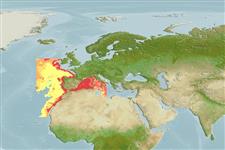Preferred temperature (Ref.
115969): 7.7 - 13.6, mean 12.9 (based on 84 cells).
Phylogenetic diversity index (Ref.
82804): PD
50 = 0.5161 [Uniqueness, from 0.5 = low to 2.0 = high].
Bayesian length-weight: a=0.00182 (0.00087 - 0.00380), b=3.05 (2.85 - 3.25), in cm Total Length, based on LWR estimates for this species & (Sub)family-body (Ref.
93245).
Trophic level (Ref.
69278): 3.9 ±0.1 se; based on diet studies.
جهندگی (Ref.
120179): متوسط, كمينه زمان لازم براي دو برابر شدن جمعيت 4/1 – 4/4 سال (Preliminary K or Fecundity.).
Fishing Vulnerability (Ref.
59153): Low vulnerability (16 of 100).
